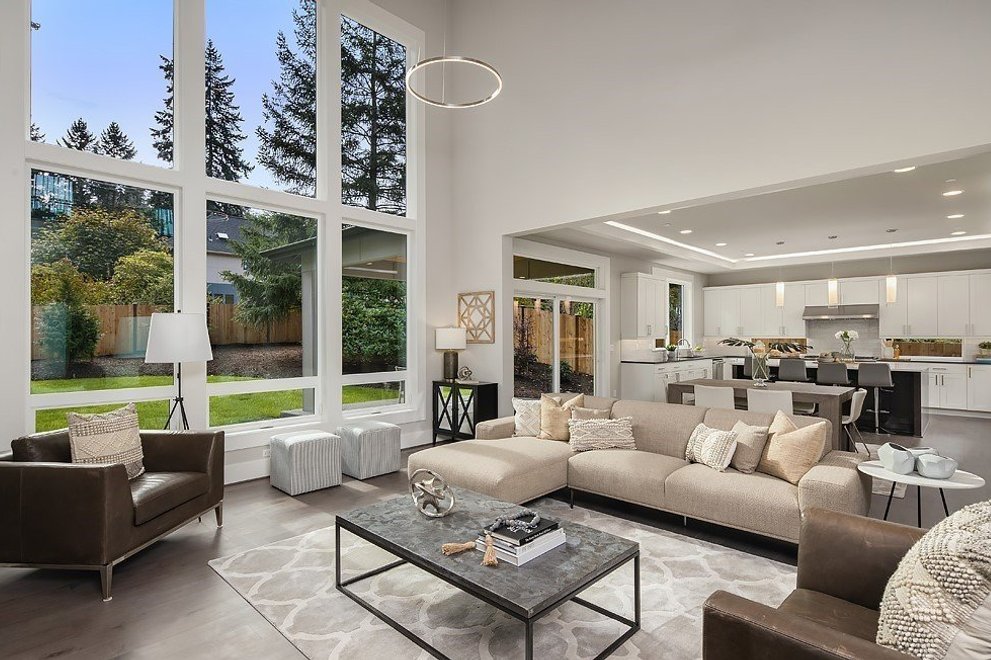What is an Open-Concept Minimalist Home Layout?

An open-concept minimalist home layout refers to a design style that eliminates traditional walls and barriers, creating a seamless and spacious living area. This layout combines the kitchen, living, and dining areas into a single, open space, promoting a sense of freedom and flexibility. The minimalist aspect of this design focuses on simplicity, using clean lines, minimal ornamentation, and a limited color palette to create a calming and uncluttered environment.
Benefits of Open-Concept Minimalist Home Layouts
- Improved Social Interaction: Open-concept layouts encourage social interaction and communication among family members and guests, as there are no physical barriers to divide the space.
- Increased Natural Light: With fewer walls and obstacles, natural light can flow freely throughout the space, reducing the need for artificial lighting and creating a brighter, more welcoming atmosphere.
- Enhanced Flexibility: Open-concept layouts offer flexibility in terms of furniture arrangement and usage, allowing homeowners to adapt the space to their changing needs and preferences.
- Simplified Maintenance: With fewer walls and surfaces, open-concept layouts require less maintenance and upkeep, making them ideal for busy homeowners.
- Aesthetically Pleasing: Open-concept minimalist home layouts create a sense of elegance and sophistication, with clean lines, minimal ornamentation, and a focus on functionality.
Key Elements of Open-Concept Minimalist Home Layouts
- Open Floor Plan: The foundation of an open-concept layout, the open floor plan combines the kitchen, living, and dining areas into a single, seamless space.
- Minimal Ornamentation: Simple, unadorned surfaces and minimal decorative elements create a clean and uncluttered environment.
- Clean Lines: Straight lines, minimal curves, and a focus on functionality define the aesthetic of open-concept minimalist home layouts.
- Limited Color Palette: A restricted color scheme, often featuring neutral tones such as white, gray, and beige, contributes to the sense of calm and serenity.
- Functional Furniture: Multi-functional furniture pieces, such as storage ottomans and sofa beds, optimize the use of space and promote flexibility.
Design Tips for Creating an Open-Concept Minimalist Home Layout
- Start with a Blank Slate: Begin by removing any unnecessary walls, barriers, or obstacles to create a open and spacious environment.
- Choose Multi-Functional Furniture: Select furniture pieces that serve multiple purposes, such as a storage ottoman or a desk with built-in shelving.
- Opt for a Limited Color Palette: Restrict your color scheme to a few neutral tones to create a sense of cohesion and calm.
- Emphasize Natural Light: Make the most of natural light by using sheer curtains, blinds, or minimalist window treatments.
- Add Texture and Interest: Incorporate texture and interest through the use of rugs, throw pillows, and wall art to create a visually appealing space.
Common Challenges and Solutions
- Noise and Distractions: Use area rugs, acoustic panels, or sound-absorbing materials to minimize noise and distractions.
- Lack of Storage: Incorporate multi-functional furniture pieces, such as storage ottomans or coffee tables with built-in storage, to optimize storage space.
- Visual Clutter: Use a limited color palette, minimal ornamentation, and functional furniture to create a sense of calm and reduce visual clutter.
FAQs
- Q: What are the benefits of an open-concept minimalist home layout?
A: The benefits include improved social interaction, increased natural light, enhanced flexibility, simplified maintenance, and an aesthetically pleasing environment. - Q: How can I create a sense of separation in an open-concept layout?
A: Use area rugs, furniture arrangements, or room dividers to create a sense of separation and define different areas within the space. - Q: What are some common mistakes to avoid when designing an open-concept minimalist home layout?
A: Common mistakes include neglecting storage needs, ignoring noise and distractions, and failing to balance functionality with aesthetics. - Q: Can I incorporate traditional elements into an open-concept minimalist home layout?
A: Yes, you can incorporate traditional elements, such as vintage furniture or decorative pieces, to add warmth and character to the space. - Q: How can I make my open-concept minimalist home layout feel cozy and inviting?
A: Use throw blankets, pillows, and rugs to add texture and warmth, and incorporate plants or greenery to bring in a natural element.
Conclusion
Open-concept minimalist home layouts offer a unique and modern approach to living, emphasizing simplicity, functionality, and a sense of openness. By understanding the benefits, key elements, and design tips outlined in this article, you can create your own simplified and stylish home. Remember to balance functionality with aesthetics, and don’t be afraid to incorporate traditional elements or add warmth and texture to the space. With an open-concept minimalist home layout, you can enjoy a sense of freedom, flexibility, and elegance, making your home a true reflection of your personal style and preferences.
Closure
Thus, we hope this article has provided valuable insights into Open-concept minimalist home layouts. We hope you find this article informative and beneficial. See you in our next article!